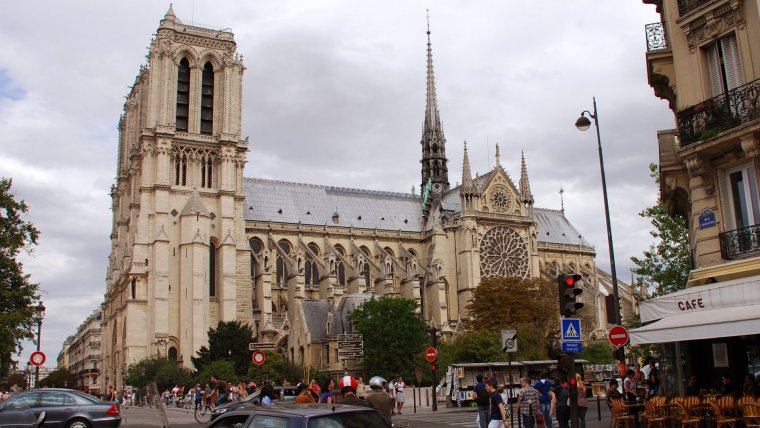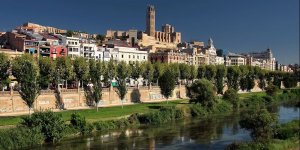| Travel / Tourist Attractions |
Notre-Dame de Paris, France

Notre-Dame. Photo: Cătălin Kislinger / Titi Tudorancea Travel Info
Notre-Dame de Paris, also known as Notre-Dame Cathedral or simply Notre-Dame, is a medieval Catholic cathedral on the Île de la Cité in the fourth arrondissement of Paris, France. The cathedral is widely considered to be one of the finest examples of French Gothic architecture, and is among the largest and most well-known church buildings in the world.
The cathedral treasury contains a reliquary which houses some of Catholicism's most important relics, including the purported Crown of Thorns, a fragment of the True Cross, and one of the Holy Nails.
In the 1790s, Notre-Dame suffered desecration in the radical phase of the French Revolution when much of its religious imagery was damaged or destroyed. An extensive restoration supervised by Eugène Viollet-le-Duc began in 1845. A project of further restoration and maintenance began in 1991.
Construction history
In 1160, because the church in Paris had become the "Parish church of the kings of Europe", Bishop Maurice de Sully deemed the previous Paris cathedral, Saint-Étienne (St Stephen's), which had been founded in the 4th century, unworthy of its lofty role, and had it demolished shortly after he assumed the title of Bishop of Paris.
As with most foundation myths, this account needs to be taken with a grain of salt; archeological excavations in the 20th century suggested that the Merovingian cathedral replaced by Sully was itself a massive structure, with a five-aisled nave and a façade some 36m across. It is possible therefore that the faults with the previous structure were exaggerated by the Bishop to help justify the rebuilding in a newer style.
According to legend, Sully had a vision of a glorious new cathedral for Paris, and sketched it on the ground outside the original church.
To begin the construction, the bishop had several houses demolished and had a new road built to transport materials for the rest of the cathedral. Construction began in 1163 during the reign of Louis VII, and opinion differs as to whether Sully or Pope Alexander III laid the foundation stone of the cathedral. However, both were at the ceremony. Bishop de Sully went on to devote most of his life and wealth to the cathedral's construction.
Construction of the choir took from 1163 until around 1177 and the new High Altar was consecrated in 1182 (it was normal practice for the eastern end of a new church to be completed first, so that a temporary wall could be erected at the west of the choir, allowing the chapter to use it without interruption while the rest of the building slowly took shape).
After Bishop Maurice de Sully's death in 1196, his successor, Eudes de Sully (no relation) oversaw the completion of the transepts and pressed ahead with the nave, which was nearing completion at the time of his own death in 1208. By this stage, the western facade had also been laid out, though it was not completed until around the mid-1240s.
Numerous architects worked on the site over the period of construction, which is evident from the differing styles at different heights of the west front and towers. Between 1210 and 1220, the fourth architect oversaw the construction of the level with the rose window and the great halls beneath the towers.
The most significant change in design came in the mid 13th century, when the transepts were remodeled in the latest Rayonnant style; in the late 1240s Jean de Chelles added a gabled portal to the north transept topped off by a spectacular rose window. Shortly afterwards (from 1258) Pierre de Montreuil executed a similar scheme on the southern transept.
Both these transept portals were richly embellished with sculpture; the south portal features scenes from the lives of St Stephen and of various local saints, while the north portal featured the infancy of Christ and the story of Theophilus in the tympanum, with a highly influential statue of the Virgin and Child in the trumeau.
Timeline of construction
• 1160 Maurice de Sully (named Bishop of Paris) orders the original cathedral demolished.
• 1163 Cornerstone laid for Notre-Dame de Paris; construction begins.
• 1182 Apse and choir completed.
• 1196 Bishop Maurice de Sully dies.
• c.1200 Work begins on western facade.
• 1208 Bishop Eudes de Sully dies. Nave vaults nearing completion.
• 1225 Western facade completed.
• 1250 Western towers and north rose window completed.
• c.1245–1260s Transepts remodelled in the Rayonnant style by Jean de Chelles then Pierre de Montreuil
• 1250–1345 Remaining elements completed.
Practical information
Opening hours:
The Cathedral is open every day of the year from 8:00 to 18:45 (19 h 15 on Saturday and Sunday). Admission is free. No luggage is allowed.
Home - information
The reception desk the Cathedral (in front of you by entering) is open:
- Monday to Friday: from 9:30 to 18:00
- Saturday and Sunday: from 9:00 to 18:00.
Offices hours
Sunday offices:
Saturday:
- 17:45: offices of the first Vespers Sunday
- 6:30 pm: mass Sunday at the high altar
Sunday (all services are held at the high altar):
- 8:30: mass
- 9:30: Office of lauds
- 10:00: mass Gregorian of the cathedral chapter
- 11:30: mass International
- 12:45: mass
- 17:45: Office of Vespers
- 6:30 pm: mass (usually presided over by the Archbishop) broadcast live on KTO - Catholic and Radio Notre Dame Television
Offices of the week, from Monday to Saturday morning:
- 08:00: mass in the chorus
- 09:00: mass in the chorus (except during the summer months: July, August and the first half of September)
- 12:00: mass at the high altar
- 17:45: Office of Vespers broadcast live on KTO TV Catholic
- 06:15 pm: mass at the high altar
Eucharistic adoration: every Thursday at the end of the mass until 19:15 and 6:15 (except during the summer months: July, August and the first half of September).
Veneration of the Crown of thorns and the relics of the Passion: the first Friday of every month and every Friday of lent 15 h 00. Friday, the veneration takes place throughout the day.
During the year of the Jubilee, exposition of the Crown of thorns, every Friday at the end of mass from 18:15 until 19:15.
Access to the Cathedral
The Cathedral is located on the island of the city, in the historical heart of Paris, next to the Hôtel-Dieu and the Prefecture of Police, a few meters from the Palais de Justice and the Sainte Chapelle.
Metro
- Line 4 Station City or St. Michael
- Line 1, 11 Station City Hall
- Line 10 Station Maubert-Mutualité or Cluny - La Sorbonne
- Lines 7, 11 and 14 Station Châtelet
RER
- Line B Station Saint-Michel - Notre-Dame
- Line C Station Saint-Michel - Notre-Dame
Vélib'
On the island of the city:
- 4001: 10 station Street Arcole
- Station 4002: place Louis Lépine
- Station 4003: 1 dock to the flowers
Left bank:
- 5009: 6 station Street from Fouarre
- Dante Street station 5008: 9
Right bank:
- Station 4017: 10 place of City Hall
- 4016: 3 station Street Lobau
RATP bus
- Line 21, 38, 47, 85, 96 Stop City - Palace of Justice
- Line 47, Balabus Stop City - square in front of Notre Dame
- Line 24, 47 Stop Notre-Dame - Quai of Montebello
- Line 24, 47 Stop Small bridge
- Line 24, 27, Balabus Stop St. Michael's bridge - quay of the goldsmiths
- Line 24, 27, 96, Balabus Stop St. Michael
- Line 21, 27, 38, 85, 96 Stop Saint-Michel - Saint-Germain
Taxi stations
• Parvis Notre-Dame at the corner of the Hôtel-Dieu (IV ° district)
• Place Saint-Michel (Fifth district)
• Place Maubert (Fifth district)
Sightseeing bus
The Red Cars: In the face of the 19 Arcola Street (IV ° district)
Open tour :
- Stop 'Notre Dame' 6, street of the city (in front of the Prefecture of Police)
- Stop "Petit-Pont" 4 Petit-Pont Street
Car parks
Parking Notre-Dame
- Place of the Parvis Notre-Dame (IV ° district)
- Open 7/7, 24/24
- Vehicles access: Street the street of the city (IV ° district)
- Pedestrian access: Parvis Notre-Dame - elevator
Parking Lutèce - city
- Palace boulevard (IV ° district)
- Open 7/7, 24/24
- Access vehicles: Boulevard of the Palace (IV ° district)
- Pedestrian access: Place Louis Lépine
City Hall parking
- Square in front of City Hall (IV ° district)
- Open 7/7, 24/24
- Access vehicles: 3 Street of the Tacherie (IV ° district)
- Pedestrian access: Place of the City Hall side street of Rivoli
- The Town Hall square on the side of Quai de Gesvres
- Victoria avenue
Parking Lobau - Rivoli
- Street Lobau (IV ° district)
- Open 7/7, 24/24
- Vehicles access: Street Lobau (IV ° district)
- Pedestrian access: Street Lobau
Parking Place St. Michel
- Street Hautefeuille (fifth district)
- Open 7/7, 24/24
- Vehicles access: Street Hautefeuille (fifth district)
- Pedestrian access: in the face of the 9 Boulevard Saint-Michel
Parking Lagrange
- Facing the 15th Street Lagrange (fifth district)
- Open 7/7, 24/24
- Access vehicles: 15 Street Lagrange (fifth district)
- Pedestrian access: 10 Street Lagrange
- 15 Lagrange St
Parking Maubert - Saint-Germain
- Facing the Boulevard Saint-Germain (fifth district) 37
- Open 7/7, 24/24
- Access vehicles: in the face of the Boulevard Saint-Germain (fifth district) 37
- Pedestrian access: 46, 38, 28, 24bis and 18 Boulevard Saint-Germain
Autolib
On the island of the city:
- Station Autolib' 5 places: 8 dock of the market new, 75004 Paris
- Station Autolib' 4 places: 23 Quay to the flowers, 75004 Paris
Left bank:
- Station Autolib' 4-seater: 1 Street Dante, 75005 Paris
Right bank:
- Station Autolib' 5 places: 17 Avenue Victoria, 75001 Paris

Notre-Dame. Photo: Cătălin Kislinger / Titi Tudorancea Travel Info
Sources:
• notredamedeparis.fr
• wikipedia.org
• Titi Tudorancea Travel Info
YOU MAY ALSO LIKE





